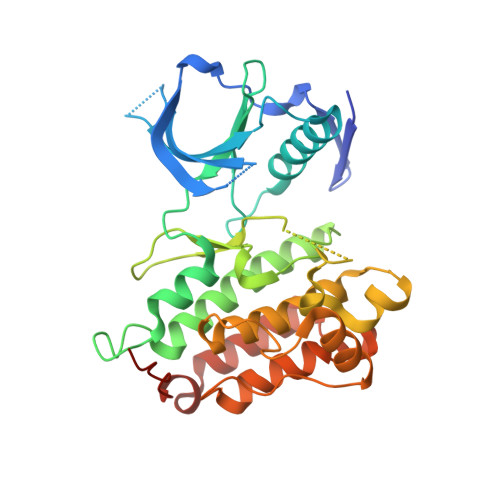The R1275Q Neuroblastoma Mutant and Certain ATP-competitive Inhibitors Stabilize Alternative Activation Loop Conformations of Anaplastic Lymphoma Kinase.
Epstein, L.F., Chen, H., Emkey, R., Whittington, D.A.(2012) J Biol Chem 287: 37447-37457
- PubMed: 22932897
- DOI: https://doi.org/10.1074/jbc.M112.391425
- Primary Citation of Related Structures:
4FNW, 4FNX, 4FNY, 4FNZ - PubMed Abstract:
Anaplastic lymphoma kinase (ALK) is a receptor tyrosine kinase that, when genetically altered by mutation, amplification, chromosomal translocation or inversion, has been shown to play an oncogenic role in certain cancers. Small molecule inhibitors targeting the kinase activity of ALK have proven to be effective therapies in certain ALK-driven malignancies and one such inhibitor, crizotinib, is now approved for the treatment of EML4-ALK-driven, non-small cell lung cancer. In neuroblastoma, activating point mutations in the ALK kinase domain can drive disease progression, with the two most common mutations being F1174L and R1275Q. We report here crystal structures of the ALK kinase domain containing the F1174L and R1275Q mutations. Also included are crystal structures of ALK in complex with novel small molecule ALK inhibitors, including a classic type II inhibitor, that stabilize previously unobserved conformations of the ALK activation loop. Collectively, these structures illustrate a different series of activation loop conformations than has been observed in previous ALK crystal structures and provide insight into the activating nature of the R1275Q mutation. The novel active site topologies presented here may also aid the structure-based drug design of a new generation of ALK inhibitors.
Organizational Affiliation:
Department of Molecular Structure and Characterization, Amgen Inc., Cambridge, Massachusetts 02142, USA.















